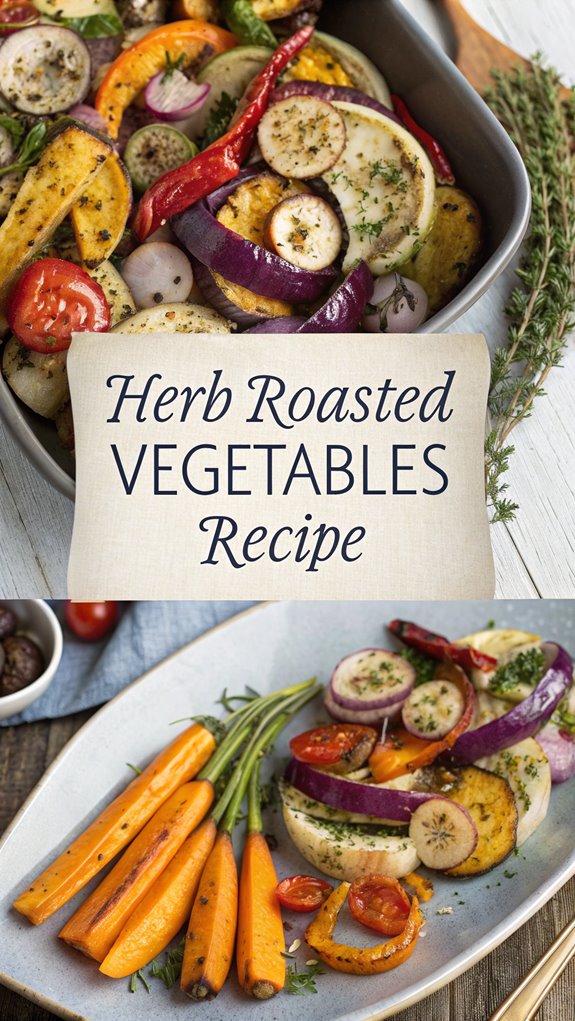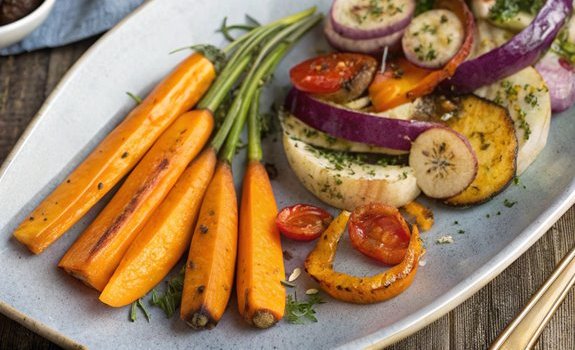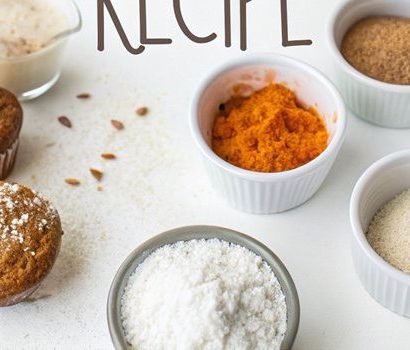Herb Roasted Vegetables
When you think about elevating your meals, herb roasted vegetables might not be the first thing that comes to mind, but they should be. Roasting brings out the natural sweetness of seasonal produce, and with the right combination of herbs, you can transform simple ingredients into a dish that’s both nutritious and satisfying. You’ll find that it’s a versatile technique, adaptable to whatever you have on hand. Yet, the question remains: how can you maximize flavor while experimenting with different herbs and vegetables? Let’s explore that.
Why You’ll Love This Recipe
You’ll absolutely love this herb roasted vegetables recipe for its simplicity and flavor. Roasting vegetables is quick and easy, requiring minimal prep time and just a standard oven. You can use a variety of root vegetables or seasonal produce, allowing for flexibility based on what’s available. Plus, you don’t have to watch them constantly; just pop them in the oven and focus on other tasks while they roast. This method not only preserves nutrients better than boiling, but it also breaks down fibrous cell walls, making nutrients easier to digest. The antioxidants released during cooking can help improve your health, while the high fiber content keeps you feeling full longer. You can customize your herb roasted vegetables by changing out herbs and spices to match your taste. Additionally, the variety of root vegetables used in this recipe allows you to experiment with different flavors and textures. They’re perfect as a side dish or a main vegetarian option. You can even prep the veggies in advance and store them in the fridge for later roasting. This recipe supports your nutritional needs while being filling and satisfying, making it a great addition to your meals any time of the year. Enjoy the delicious flavors and health benefits this recipe brings to your table!
History
Roasting vegetables has deep roots in culinary history, dating back to the discovery of fire. Ancient cultures learned to enhance natural flavors by roasting whatever vegetables were available to them. Over time, this technique spread globally, shaped by different climates and agricultural practices. You’d find a variety of vegetables being roasted, leading to a rich tapestry of traditional recipes.
In Mediterranean cuisine, the focus on fresh, seasonal produce and aromatic herbs like thyme, basil, and oregano created unique flavor profiles. Tomatoes, symbolizing life and passion, became a staple in many herb-roasted dishes. These meals were often shared in communal settings, highlighting the importance of togetherness in food. Rich in nutrients, herb-roasted vegetables provide essential vitamins and minerals that support overall health.
Root vegetables, like beets and carrots, also play a significant role in roasting history. They’ve been enjoyed for their earthy flavors and nutritional benefits, especially during colder months. Today, we enjoy them year-round.
Modern oven roasting techniques have refined these age-old methods, ensuring consistent results. By experimenting with different herb combinations and optimizing cooking times, you can enhance the nutrient availability and flavor of your vegetables, continuing a culinary tradition that has lasted for millennia.
Recipe

Herb Roasted Vegetables
Herb roasted vegetables are a delightful and versatile dish that can complement any meal. This recipe allows you to use a variety of seasonal vegetables, combining their flavors and textures while enhancing them with fragrant herbs and spices. Roasting brings out the natural sweetness of the vegetables, making them a favorite among both kids and adults. Roasting brings out the natural sweetness and depth of flavor through caramelization, creating appealing exteriors that can elevate the dish even further.
The beauty of this dish lies in its adaptability; you can mix and match your favorite vegetables and herbs to create a unique blend that suits your taste preferences. Whether served as a side dish or tossed with pasta for a hearty main course, herb roasted vegetables are sure to please. Follow the simple steps below to create this wholesome dish.
Ingredients:
– Potatoes (thin-skinned like red or Yukon gold)
– Carrots (large, peeled, and oblique cut)
– Celeriac (or other root vegetables like kohlrabi)
– Brussels sprouts (trimmed and halved if large)
– Zucchini, butternut squash, and red peppers
– Extra virgin olive oil or avocado oil
– Coarse kosher salt
– Freshly ground pepper
– Fresh or dried herbs (e.g., chives, dill, tarragon, chervil, Italian seasoning)
– Garlic powder and fresh garlic
– Lemon zest
Cooking Instructions:
-
Preheat your oven to 400°F (200°C). Prepare a non-stick baking sheet or line a baking sheet with parchment paper to prevent sticking.
-
Wash and cut your chosen vegetables into uniform chunks to guarantee even cooking. This can include a mix of potatoes, carrots, Brussels sprouts, zucchini, and any other vegetables you prefer.
-
In a large bowl, combine the cut vegetables with extra virgin olive oil, coarse kosher salt, freshly ground pepper, garlic powder, and your choice of herbs. Toss the vegetables thoroughly until they’re evenly coated.
-
Spread the seasoned vegetables in a single layer on the prepared baking sheet, making sure not to overcrowd them. This will allow for proper roasting and caramelization.
-
Roast the vegetables in the preheated oven for 20-30 minutes, or until they’re tender and golden brown. Stir the vegetables halfway through to guarantee even cooking.
-
In the last 10 minutes of roasting, sprinkle additional fresh or dried herbs over the vegetables and add minced fresh garlic if desired. This will infuse the dish with even more flavor.
-
Once the vegetables are cooked, remove them from the oven and toss them with lemon zest for a revitalizing finish. Serve warm as a side dish or mix with your favorite pasta.
Extra Tips:
For the best results, make sure to choose vegetables that are in season for enhanced flavor and nutrition.
Feel free to experiment with different herb combinations based on your main dish—dill pairs well with fish, while rosemary complements roasted meats.
Remember to adjust the cooking time based on the types and sizes of your vegetables, and always cut them into uniform sizes for even roasting.
Enjoy your herb roasted vegetables as a colorful and delicious addition to any meal!
Final Thoughts
Herb roasted vegetables not only add vibrant color and flavor to your meals but also offer a plethora of benefits for your cooking repertoire.
They’re incredibly versatile, serving as a perfect side dish alongside meat or fish, while also standing out as a tasty main course for vegetarians. By batch cooking, you can prepare large quantities, making meal prep a breeze throughout the week.
When roasting, make sure to preheat your oven to the right temperature, typically around 400°F to 425°F. Cutting your vegetables into even-sized pieces helps them cook uniformly. Toss them with oil and herbs before roasting, and remember to add delicate herbs towards the end to preserve their flavor. Additionally, using similar cooking times for your vegetables can enhance the overall roasting experience.
Don’t forget about flavor enhancers! Fresh garlic, lemon zest, and a drizzle of balsamic vinegar can elevate the taste.
You can store any leftovers in an airtight container for up to five days, allowing you to enjoy them later. By adjusting your recipe based on in-season vegetables or your elevation, you can keep your herb roasted vegetables fresh and exciting.
Embrace this cooking method and enjoy the delicious results it brings to your table.
FAQ
When it comes to preparing herb roasted vegetables, you might’ve some questions about the best practices and techniques.
First, for oils, avocado oil is your best bet due to its high smoke point. While olive oil works, it may not withstand high heat as well. Light-colored oils like vegetable, canola, or grapeseed are also suitable. Remember to use minimal oil for healthier roasting.
When roasting, spread the vegetables out in an even layer on the baking sheet. This prevents steaming and helps achieve that desired roasted texture. The roasting process enhances flavor through the caramelization of natural sugars, making it a popular choice for holiday meals.
Keep an eye on cooking times; heartier veggies like potatoes need longer, while broccoli may char quickly, so you might want to remove it earlier.
For herbs, dried varieties are recommended to avoid burning. Italian seasoning, thyme, and rosemary can elevate the flavors.
If you have leftovers, store them in an airtight container in the fridge for up to five days. Mixing different types of vegetables guarantees you get a variety of nutrients, making your meals both delicious and healthy.
Enjoy experimenting with your herb roasted vegetables!



